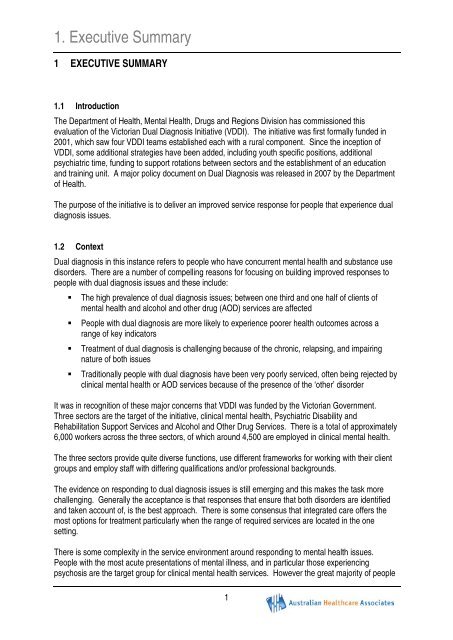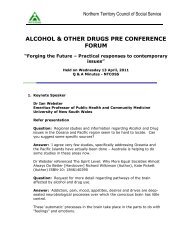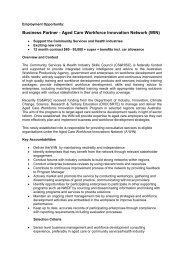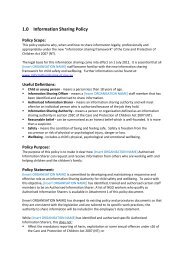(2011) Evaluation of the Victorian Dual Diagnosis Initiative
(2011) Evaluation of the Victorian Dual Diagnosis Initiative
(2011) Evaluation of the Victorian Dual Diagnosis Initiative
You also want an ePaper? Increase the reach of your titles
YUMPU automatically turns print PDFs into web optimized ePapers that Google loves.
1. Executive Summary<br />
1 EXECUTIVE SUMMARY<br />
1.1 Introduction<br />
The Department <strong>of</strong> Health, Mental Health, Drugs and Regions Division has commissioned this<br />
evaluation <strong>of</strong> <strong>the</strong> <strong>Victorian</strong> <strong>Dual</strong> <strong>Diagnosis</strong> <strong>Initiative</strong> (VDDI). The initiative was first formally funded in<br />
2001, which saw four VDDI teams established each with a rural component. Since <strong>the</strong> inception <strong>of</strong><br />
VDDI, some additional strategies have been added, including youth specific positions, additional<br />
psychiatric time, funding to support rotations between sectors and <strong>the</strong> establishment <strong>of</strong> an education<br />
and training unit. A major policy document on <strong>Dual</strong> <strong>Diagnosis</strong> was released in 2007 by <strong>the</strong> Department<br />
<strong>of</strong> Health.<br />
The purpose <strong>of</strong> <strong>the</strong> initiative is to deliver an improved service response for people that experience dual<br />
diagnosis issues.<br />
1.2 Context<br />
<strong>Dual</strong> diagnosis in this instance refers to people who have concurrent mental health and substance use<br />
disorders. There are a number <strong>of</strong> compelling reasons for focusing on building improved responses to<br />
people with dual diagnosis issues and <strong>the</strong>se include:<br />
• The high prevalence <strong>of</strong> dual diagnosis issues; between one third and one half <strong>of</strong> clients <strong>of</strong><br />
mental health and alcohol and o<strong>the</strong>r drug (AOD) services are affected<br />
• People with dual diagnosis are more likely to experience poorer health outcomes across a<br />
range <strong>of</strong> key indicators<br />
• Treatment <strong>of</strong> dual diagnosis is challenging because <strong>of</strong> <strong>the</strong> chronic, relapsing, and impairing<br />
nature <strong>of</strong> both issues<br />
• Traditionally people with dual diagnosis have been very poorly serviced, <strong>of</strong>ten being rejected by<br />
clinical mental health or AOD services because <strong>of</strong> <strong>the</strong> presence <strong>of</strong> <strong>the</strong> ‘o<strong>the</strong>r’ disorder<br />
It was in recognition <strong>of</strong> <strong>the</strong>se major concerns that VDDI was funded by <strong>the</strong> <strong>Victorian</strong> Government.<br />
Three sectors are <strong>the</strong> target <strong>of</strong> <strong>the</strong> initiative, clinical mental health, Psychiatric Disability and<br />
Rehabilitation Support Services and Alcohol and O<strong>the</strong>r Drug Services. There is a total <strong>of</strong> approximately<br />
6,000 workers across <strong>the</strong> three sectors, <strong>of</strong> which around 4,500 are employed in clinical mental health.<br />
The three sectors provide quite diverse functions, use different frameworks for working with <strong>the</strong>ir client<br />
groups and employ staff with differing qualifications and/or pr<strong>of</strong>essional backgrounds.<br />
The evidence on responding to dual diagnosis issues is still emerging and this makes <strong>the</strong> task more<br />
challenging. Generally <strong>the</strong> acceptance is that responses that ensure that both disorders are identified<br />
and taken account <strong>of</strong>, is <strong>the</strong> best approach. There is some consensus that integrated care <strong>of</strong>fers <strong>the</strong><br />
most options for treatment particularly when <strong>the</strong> range <strong>of</strong> required services are located in <strong>the</strong> one<br />
setting.<br />
There is some complexity in <strong>the</strong> service environment around responding to mental health issues.<br />
People with <strong>the</strong> most acute presentations <strong>of</strong> mental illness, and in particular those experiencing<br />
psychosis are <strong>the</strong> target group for clinical mental health services. However <strong>the</strong> great majority <strong>of</strong> people<br />
1










